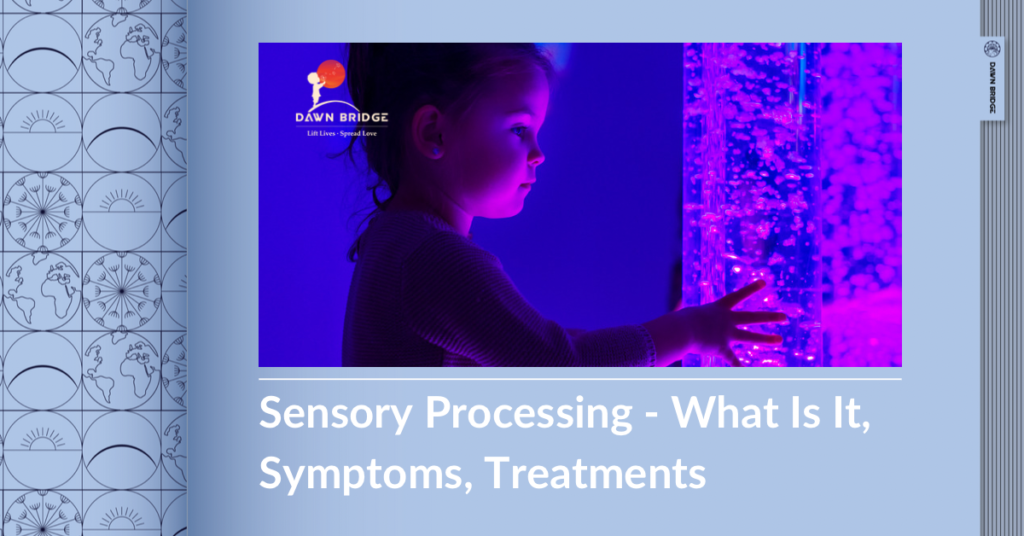Sensory processing is a subconscious and automatic neurological process that occurs in everyone at all stages. Our brain receives multisensory input, including general senses and special senses and then integrates them so we can respond according to particular situations and demands.
Evolution of The Theory of Sensory Processing And Sensory Integration
- Dr Jean Ayres
Sensory integration theory was firstly proposed in 1965.
- Dr Winnie Dunn
Developed a tool called Sensory Profile for the evaluation of sensory functions.
- Dr Lucy Miller
Proposed to replace the term “sensory integration dysfunction” with “sensory processing disorder.”
Proposed to differentiate “sensory integrative dysfunction” into three categories: sensory modulation disorder, sensory discrimination disorder, and sensory-based motor disorder.
- Neuroscientists include Stein, Meredith and Wallace.
Examines sensory integration at the cellular level, known as Multisensory Integration (MSI).
What is a sensory processing disorder?
It is also known as sensory integration dysfunction. Both terms are used interchangeably by scientists. Sensory processing disorder is when the brain has difficulty receiving and responding to information through the senses. It is not currently recognised as a distinct medical diagnosis.
What are the signs of sensory processing disorder?
There are many variations of symptoms and signs of sensory processing disorder.
Here are listed examples of symptoms and signs related to senses.
- Tactile defensiveness
- E.g., Experience discomfort walking barefoot on certain floor textures such as carpet or beaches.
- Tactile seeking
- E.g., Show little to no reaction to pain stimuli
- Proprioceptive seeking
- E.g., Purposely hitting or pushing other peers.
- Proprioceptive difficulties
- E.g., Do not know the idea of light weighted and heavy weighted.
- Auditory defensiveness
- E.g., Emotional breakdown to unexpected or loud noises.
- Auditory hyposensitivity
- E.g., Enjoy making certain sounds.
- Olfactory hypersensitivity
- E.g., Reacts strongly to certain smells that generally do not bother others.
- Olfactory hyposensitivity
- E.g., Cannot differentiate different types of smell
- Visual hypersensitivity
- E.g., Avoids eye contact
- Visual hyposensitivity
- E.g., Difficulty in visual tracking moving items
- Vestibular hypersensitivity
- E.g., Avoid spinning.
- Vestibular hyposensitivity
- E.g.,Love to spin for a prolonged period without feeling dizziness
Types
Sensory processing disorder is only accepted in the Diagnostic Classification of Mental Health and Developmental Disorders of Infancy and Early Childhood (DC:0-3R). This developmentally based diagnostic provides clinical criteria for categorising infant and toddler mental health and developmental disorders. It is only used for complementing ICD-10 of WHO and DSM-5.
Based on the theory by Dr Jean Ayres, sensory integration and processing difficulties are divided into
- Dyspraxia
- Poor bilateral integration
- Visual perceptual deficits
- Somatodyspraxia
- Auditory-language problems

Based on the theory by Dr Lucy Miller and the book Diagnostic Classification of Mental Health and Developmental Disorders in Infancy and Early Childhood, Sensory Processing Disorder (SPD) divided into
- Sensory modulation disorder (SMD): Failed to adjust features of the neural message, including intensity, frequency, duration, complexity, and novelty.
- Subtypes of SMD:
- Sensory over-responsivity
- Sensory under-responsivity
- Sensory craving/seeking
- Subtypes of SMD:
- Sensory-based motor disorder (SBMD): Motor output is disorganised as incorrect processing of sensory information affects postural challenges or developmental coordination disorder.
- Subtypes of SBMD:
- Dyspraxia
- Postural disorder
- Subtypes of SBMD:
- Sensory discrimination disorder (SDD): Incorrect processing of sensory information
- Subtypes of SDD
- Visual
- Auditory
- Tactile
- Gustatory
- Olfactory
- Vestibular
- Proprioceptive
- Interoception
- Subtypes of SDD
What causes sensory processing disorder?
It’s not clear what causes sensory processing disorders in children. Studies show disorder may be related to prenatal or birth complications, which can include:
- Premature birth
- Low birth weight
- Parental stress
- Alcohol or drug consumption during pregnancy
How is sensory processing disorder diagnosed?
Diagnosing sensory processing disorder can be challenging and normally followed by a screening test performed by an occupational therapist or a physiotherapist. To obtain an appropriate diagnosis based on clinical observations and parent reports of symptoms, which provide clues for treatment.
The standardised assessment tool used to diagnose SPD is the Sensory Integration and Praxis Tests.
The medical professionals will assess the seven senses, including vision, auditory, gustatory, tactile, olfactory, proprioception, and vestibular.
How is sensory processing disorder treated?
The occupational therapist often carries out SPD treatment to help them retrain or restore the senses. This treatment is known as Sensory Integration (SI)Therapy. The goal of the treatments will focus on regaining daily life skills.
Depending on the senses involved, treatments may include:
- Physical therapy using a sensory integration approach (PT-SI)
- Vision therapy: Practitioners will use prisms and visual arousal activities to improve the patient’s vision.
- Sound therapy: Patients listen to electronically altered music and perform sensory activities.
If You’re Concerned
Although many psychiatrists do not recognise sensory processing disorder, you may still manage SPD with several therapeutic options. But treatment isn’t a one-size-fits-all approach. It’s essential to work with your doctors, occupational therapists and physiotherapists if you think you need a comprehensive and integrated treatment plan.
Visiting our site today, share your concerns and what you’re seeing. There are many ways to support kids diagnosed with sensory processing disorder – helping them feel less alone and connect to the world.
So welcome to Dawn Bridge. We’re thrilled that you’ve joined us on this journey.
References
- https://animatedlanguagelearning.com/sensory-integration-therapy-and-jean-ayres/
- https://napacentre.com.au/spd-checklist/
- https://www.webmd.com/children/sensory-processing-disorder
- Zeanah CH, Carter AS, Cohen J, Egger H, Gleason MM, Keren M, Lieberman A, Mulrooney K, Oser C. DIAGNOSTIC CLASSIFICATION OF MENTAL HEALTH AND DEVELOPMENTAL DISORDERS OF INFANCY AND EARLY CHILDHOOD DC:0-5: SELECTIVE REVIEWS FROM A NEW NOSOLOGY FOR EARLY CHILDHOOD PSYCHOPATHOLOGY. Infant Ment Health J. 2016 Sep;37(5):471-5. doi: 10.1002/imhj.21591. Epub 2016 Aug 29. PMID: 27570937.
- https://mysoundtherapy.com/us/wp-content/uploads/USA-rp-the-effect-of-sound-based-intervention-on-children-with-spd-1.pdf

